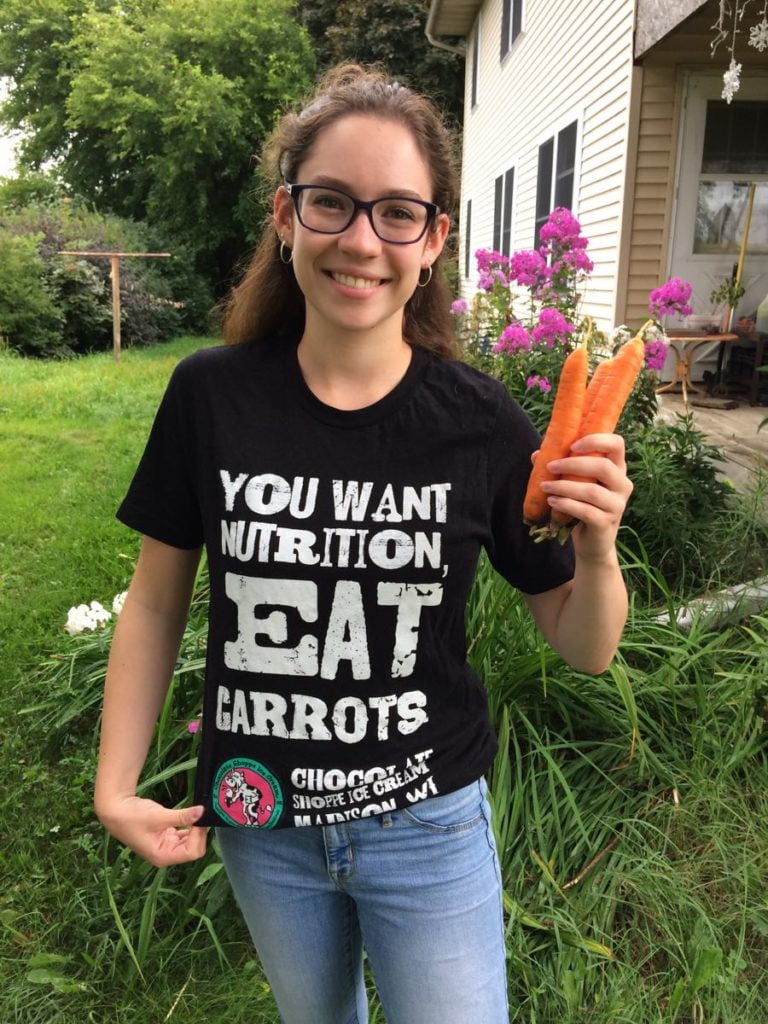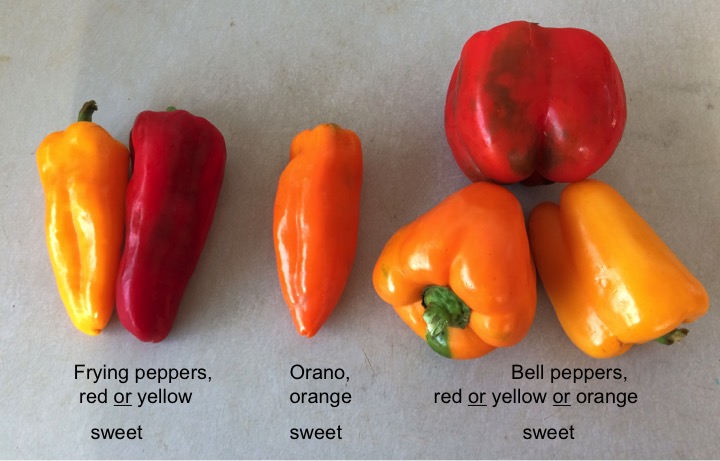Week #14, August 20/21, 2018
- On: August 22, 2018
 0
0
Weather report
Occasionally, I ask Steve what information he’d like to share in the newsletter. Without fail, he says “the heat wave,” “how wet it is,” or “what a windy week.” Weather is a big deal for any farm. I stopped writing about weather in the newsletter after a few years when it became monotonous. Also, I try to obsess less about the weather than Steve does. This week is different because of the intense rain on Monday.
We are fine and the farm is fine. Thank you to everyone who expressed concern. We were lucky (!) to get just 3 inches, combined with Friday’s rain for a total of 6 inches. That left our fields muddy but undamaged. We are usually grumpy about 6″ but that’s nothing compared to the 11″ and 15 ” that fell in Middleton and Cross Plains respectively. The news footage was terrible. Tipi members in that area, we hope you are OK. We’re hoping for the best for our farmer friends west of Madison too. Word is still trickling in how everyone fared.
Heavy rain takes a toll. Repeated rain takes a toll. It’s worth discussing how this summer’s extended wet weather has affected the farm. We’ve had wet spells before but this is a genuinely wet summer. Too much rain has lasting effects.
Too much rain = weeds. The fields are too wet to cultivate or hoe. Our fall crops are getting so, so weedy. Steve is anxious about recovering control of those fields.
Too much rain = disease. Oh, the tomato plants are not happy. In messages with farmer friends yesterday, everyone was sad about their tomato fields. Leaf diseases are rampant. Enjoy this week’s tomatoes because we don’t know how long we’ll have them. Weather like this shortens a tomato season. There’s not much we can do about it. We really need the rain to stop before it causes trouble with our fall brassica crops (broccoli, cabbage, cauliflower, greens). They look fine so far but wet weather causes problems as the nights get cooler in fall.
Too much rain = rot. We harvested tomatoes a little underripe this week because the ripest fruits split. We also picked bell peppers less ripe than usual. If water sits in the sunken area of a pepper crown, there’s too much risk it will go bad. It’s better to pick the pepper early. Storage life can be shorter too because the fruits are fragile and loaded with water. It’s not a disease problem, but some vegetables are less flavorful if they mature during wet weather. Tomatoes in particular can taste watery and diluted. They have their best, concentrated flavor under sunny, dry conditions.
What’s the upside? What’s done well this season? It has been a ridiculously productive summer for every crop in the cucurbit (squash) family. That’s muskmelons, watermelons, cucumbers, zucchini, etc. I was concerned about overwhelming you with cucumbers but kept sending them. That’s the CSA deal, right? When a crop thrives, we all share in the bounty. We hope the winter squash and pumpkins do as well. We’ll find out next month. Beth
Irony

Our daughter worked at a Chocolate Shoppe ice cream shop this summer. (She also interned at Olbrich Gardens.) Check out her work t-shirt. That gave us such a laugh.
#2 Grade Red Peppers
I write about pepper grading every year. Returning members can say “yeah, yeah” and skip ahead. New members, please read.
Many of the red bell peppers we send in the CSA boxes will be our #2 grade. We do this to avoid waste and to deliver good value to our CSA members. The #2 grade peppers are excellent eating quality, but are not quite pretty enough to sell to stores. As a result, we place a much lower value on these peppers. This allows us to provide generous amounts of peppers over the course of the season. We feel this is a good exchange, even if it means you occasionally open a pepper and find that it needs trimming. Here are the reasons that peppers are downgraded from #1 grade to #2 grade:
- They may have a minor blemish, or
- They may have minor insect damage, or
- They may be very ripe and beginning to wrinkle. (These are especially sweet and delicious as they are fully ripe. These cannot be sold to stores because their shelf life is short. You will find that the texture is less crisp than a #1 grade pepper, but the flavor more than makes up for it.)
- They might be partially red and partially green.
- Others are just too small.
The eating quality is fine (or excellent) for all these #2 peppers. We throw away ALL peppers that we suspect have rot inside (although one may occasionally slip through in either #1 or #2 grade.)
This week’s peppers

This week’s peppers are a mix of #1 and #2 grade. Everyone receives some of the sweet peppers above, for a total about four peppers.
– Frying peppers are thin-walled with low moisture, which allows them to fry readily in hot oil. They are so fragrant! Identify this week’s frying peppers by their slender shape and color (red or yellow).
– Oranos are sweet snacking peppers. They resemble frying peppers but don’t fry as well. If you get an Orano, just eat it as a snack. The flavor is excellent and they have few seeds. All Oranos peppers are orange (or orange and green.)
– Bell peppers are thicker-walled and juicy, great for eating raw in salads or roasting on the grill. This week’s bells are mostly red, but a few sites will get an orange or yellow bell.
Veggie List and Veggie Notes
Week #14, August 20/21, 2018
Weekly, purple EOW, sun SMP
Sweet corn, 9 – 10 ears
‘New Orchid’ orange watermelon
Tomatoes, plum, ~1.6 lb
Tomatoes, slicing, ~3.3 lb
Cucumber, 1
Silver Slicer cuke, 1
Colored bell peppers, 2
Frying peppers OR Orano, 2
Yellow onion, 1 or 2
Cilantro, 1 bunch
Next week’s box will probably contain melon, peppers, tomatoes, onions, hot pepper, garlic, an herb and more.
Sweet corn – This week’s variety is ‘Fabulous.’ The seed breeders are not modest but they don’t need to be. This is a very excellent corn variety. We got a lot of positive feedback about last week’s corn. This batch is just as good, maybe better.
‘New Orchid’ watermelon – This is my (Beth) favorite type of watermelon, with beautiful sherbet orange color, great flavor and texture.
Tomatoes – OK, we’ve hit peak tomato season. This week, more tomatoes than usual are slightly underripe; the ripest tomatoes split after the heavy rain.
Storage: Store at room temperate on your kitchen counter. Watch closely. If soft spots develop, eat quickly.
Other storage: If there are more than you can use, just freeze the extras. We freeze plum tomatoes intact and whole. When it’s time to use them, we run the frozen tomatoes under tepid water and the skins slip right off. This should work with slicers too. It’s OK to cut up either type and freeze in a bag or container to save freezer space.
Yellow onion – This is the first storage onion of the season. These have lower moisture than sweet Walla Wallas, so these will fry nicely. Storage: please refrigerate this week’s onion to be sure it stays in good shape.
RECIPES
Visit our 2018 Recipe Log or our 2017 Recipe Log or join our Facebook discussion group.
LOCAL THYME/ Comforting Classics
Watermelon Cucumber Feta Skewers
Corn, Pepper and Tomato Flatbreads
Black Beans and Yellow Rice
Chicken Cacciatore
LOCAL THYME/ Outside the Box Recipes
Watermelon Vinaigrette
Mexican Corn Salad
Stuffed Pepper Soup
Tomato Salad with Lime and Herbs
LOCAL THYME/ Quick & Easy Meal
Quinoa Salad with Watermelon, Cucumber and Cilantro
RECIPES FROM LAUREN
SUMMER TIME PIZZA
Serves 2-4.
Takes 30 minutes (if using store-bought or already prepared dough; takes 90 minutes if making dough from scratch).
1 batch favorite pizza dough
1 large red bell pepper
2 tablespoons olive oil, divided
3/4 cup whole-milk ricotta (or tomato sauce or pesto if you prefer)
2-3 tomatoes, cored and sliced
1/4 yellow onion, thinly sliced
2 ears corn, cooked however you find easiest (in a pot of boiling water for 3 minutes, on the grill or in the microwave)
1 cup shredded mozzarella
1/2 teaspoon Kosher salt
1/4 teaspoon freshly ground black pepper
1/4 teaspoon red pepper flakes
2-3 tablespoons roughly chopped cilantro
- If making your dough from scratch (and it isn’t already prepped) make that first and get it rising.
- Preheat the broiler of your oven to high. Place a small piece of parchment paper on your pizza pan. Add red pepper and roast under high heat of broiler for 10-12 minutes, rotating occasionally until all sides are blackened. (This can also be done on a grill if you are using it for some other reason).
- As soon as the peppers are done in the oven turn off the broiler and preheat the oven to 525 degrees (or as hot as the oven will go). Place your pizza pan in the oven immediately (even as it preheats).
- Let red pepper sit for 5 minutes outside of the oven and then peel off skin as best you can. Remove the seeds from the pepper and slice thinly.
- Roll out your risen pizza dough. Remove the pan from the oven and quickly drizzle with a tablespoon of oil. Add pizza dough. It hopefully will sizzle a bit. Using a spatula, spread ricotta over dough followed by tomatoes, peppers, onions and sweet corn. Add mozzarella then sprinkle with salt, pepper and red pepper flakes. Drizzle with remaining tablespoon oil and then place in hot oven. Bake for 10-13 minutes until crust begins to turn golden brown. If the cheese is nicely browned, perfect! If not, feel free to turn the broiler back on for just a couple minutes.
- Serve warm with a sprinkle of cilantro and more salt to taste.
.
WATERMELON GAZPACHO
Adapted slightly from Bon Appetit
Serves 2-4.
Takes 25 minutes (excluding time to chill gazpacho).
4 cups cubed watermelon, seeds removed
2 pounds tomatoes, cored and roughly chopped
1 cucumber, peeled, seeded and roughly chopped
1/2 Silver Slicer, peeled, seeded and roughly chopped
1 red frying pepper, seeds removed and roughly chopped
2 tablespoons olive oil
2 tablespoons Sherry vinegar (or red wine vinegar)
Kosher salt
Freshly ground black pepper
For serving:
1/4 cup almonds, toasted and coarsely chopped
2 ounces feta, crumbled
1/4 cup Greek yogurt
3 tablespoons whole milk
1 cup watermelon (cut into 1/2-inch pieces)
1/2 silver slicer, seeded, peeled and cut into 1/2-inch pieces
More olive oil
More Kosher salt
More freshly ground black pepper
- Puree watermelon, tomato, cucumber, red pepper, oil, and vinegar in a food processor or blender until smooth.
- Transfer to a large bowl; season with salt and pepper. Cover and chill for at least 1 hours before serving.
- To prepare topping, combine feta, yogurt and milk in a small bowl. Whisk with a fork until combined. It won’t be smooth because of the feta; that’s how it should be so don’t stress.
- Serve chilled gazpacho with a dollop of feta mixture, some almonds, some cubed watermelon and cucumbers, a drizzle of olive oil and more salt and pepper.
.



